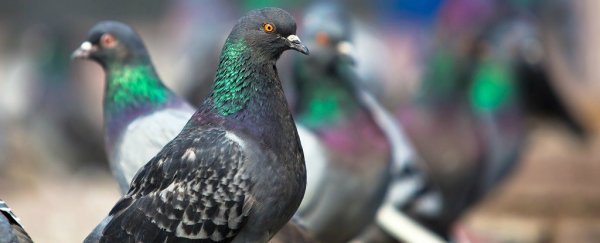A new study has suggested that pigeons can be taught to read, and might be able to distinguish 'words' from 'non-words'.
This makes pigeons one of the few animals on Earth that have been taught to read – an exclusive club including humans, monkeys, and a dog called Willow.
Scientists from the University of Otago in New Zealand started off with 18 pigeons (Columba livia), and whittled them down to the smartest four using a type of conditioning called autoshaping.
Autoshaping involves flashing a light through a hole (or aperture) to get the subject's attention, and after a couple of seconds, food appears from a little food tray called a hopper.
Basically, with enough repeats, the subject learns that after light comes food, so the birds will begin pecking at the light as if it was their dinner.
The video below shows how the process works – except in this experiment, there were three apertures instead of one, and words were eventually introduced in the aperture:
"After hopper training, an autoshaping procedure was used until subjects were consistently pecking stimuli presented in any of the three apertures," the researchers explain. "After shaping, subjects were presented with their first word."
A "word" in this case was one of a series of simple English words such as "very", whereas a "non-word" is a series of letters that equate to nonsense, such as "vrey".
The experiment also involved something called a star stimulus - a star icon that the bird was trained to peck if they thought the word they were being shown was incorrect. Each time the bird correctly identified a word or non-word, they were rewarded with food from the hopper.
The star stimulus was presented in random positions, either above or below the word or non-word - easy visible for the winged readers.
"Word and non-word stimuli were presented in the centre square aperture," the researchers explained. "When a word was presented in the centre aperture, the correct response was to peck the word. When a non-word was presented in the centre aperture, the correct response was to peck the star stimulus."
Each pigeon saw the first word 50 times, mixed in with a number of non-words. Once they'd mastered one word, another word was added, with all old words maintained through the program.
The four 'smartest' birds managed to learn a mean of 43 words, with each bird having been trained for over eight months.
So, alright, these pigeons aren't geniuses, but by animal standards, that's pretty impressive. One of the four, named Q35, even managed to learn a staggering 58 words by the end of the experiment.
The pigeons did surprisingly well on differentiating the words, with the researchers pointing out that the pigeons were able to distinguish new words from familiar ones.
They also displayed certain hallmarks of what's called orthographic processing, which is the visual system that allows the brain to form, store, and recall words – one of several factors that humans use to read.
In one particular type of test – substituted words (such as 'door' to 'daar') – the four smartest birds did even better than baboons in previous experiments.
"On this measure, the pigeons' performance is actually more comparable to that of literate humans than the baboons' performance," the researchers wrote.
"Indeed, pigeons' differential performance on known words and transposed words suggests they were highly sensitive to the relative position of the letters within words."
So how the hell did the pigeons actually do it?
The researchers suggest that they might be learning to read using a controversial and hypothetical system known neuronal recycling.
The neuronal recycling hypothesis is an attempt to explain how humans developed the ability to read and write. As a species, we've only been reading and writing for the past few thousand years, and that's not enough time for evolution to be the driving force behind such a huge change. So what was?
The team suggests that rather than our brains physically changing through hundreds of thousands of years of evolution to facilitate reading, our neurons might instead have shifted their functionality to attach words to pictures, and therefore meaning.
"One intriguing possibility is that the VWFA (Visual Word Forming Area) [in the brain] is the product of neuronal recycling, with its neurons learning to code visual stimuli (i.e., words) that greatly differ from the visual objects it initially evolved to code," they write.
And although humans can learn to attach words to pictures, and eventually meaning, let's be clear - these pigeons are not attaching any meaning to the words they're being shown, apart from the obvious 'I'll get fed if I get this right' conditioning.
This means that although the pigeons can identify, or 'read', certain words, they have no idea what something like "very" actually means. So our definition of reading and their reading are definitely not equal.
But research has now shown that with enough training, baboons, and the occasional smart pigeon or dog, can be taught to perform a rudimentary form of reading, potentially by recycling their brain circuitry to recognise words and letters. No evolution required.
"These findings demonstrate that visual systems neither genetically nor organisationally similar to humans can be recycled to represent the orthographic code that defines words," the researchers conclude.
We'll have to keep an eye out for follow-up studies, as the idea of neuronal recycling is still hotly contested, and with only four pigeons being tested this time around, it's definitely not a definitive study.
But not a lot of creatures on Earth have been shown to have this ability, so that's at least one more reason to begrudgingly respect the rats of the sky.
The results have been published in the Proceedings of the National Academy of Sciences.
